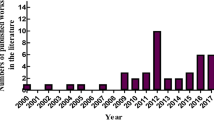Abstract
This article is intended to provide background information on leachate management in closed landfill sites based on a comparison of two landfill sites and the identification of leachate characteristics depending on the final cover and the season. Site S is older and has no final cover, while site J is younger and has final capping. The results of leachate analysis from the two landfills show that the biological oxygen demand to chemical oxygen demand ratio decreases below 0.1 to the range 0.05–0.07 for site S, whereas the ratio at site J was in the range 0.08–0.55. The inorganic nitrogen concentration was in the range 169.9–386.1 mg/l with an average of 265.2 mg/l at site S. Ammonia nitrogen accounted for 98.9% of the total nitrogen. The absence of a final cover on closed landfill sites may contribute to the stabilization of such landfills due to flushing. The nitrogen content at landfill S dropped in the summer, whereas it decreased in the fall at site J. A higher fluctuation in the pollutant levels of organic matters and nitrogen at the younger landfill site was observed, compared to the older site, even though the younger site had final capping. Therefore, intensive leachate management should be arranged at the early stages after closing for proper treatment. Specifically, nitrogen management of leachate is a critical factor in treatment operations.
Similar content being viewed by others

References
O’Leary P, Walsh P (1995) Decision maker’s guide to solid waste management, vol 2. Solid and Hazardous Waste Education Center, University of Wisconsin, Millwaukee
Tchobanoglous G, Theisen H, Vigil S (1993) Integrated solid waste management. McGraw-Hill, New York, pp 421–422
Robinson H (2007) The composition of leachates from the very large landfills: an international review. Commission on Water Resource Management 8(1):20
Chen T, Esnault D, Koenig A (1997) First year operation of the MENT landfill leachate treatment works in Hong Kong. In: Proceedings of the Sixth International Landfill Symposium. Cagliari, Italy, 13–17 October 1997, pp 219–228
Kjeldsen P, Christophersen M (2001) Composition of leachate from old landfills in Denmark. Waste Manag Res 19(3):249–256
Reinhart DR, Grosh CJ (1998) Analysis of Florida MSW landfill leachate quality. Center for Solid and Hazardous Waste Management, Report 97:3, Florida
Pacey JG (1999) Benefits and quantifications of performance expectations for an anaerobic bioreactor landfill. In: Proceedings of the Seventh International Waste Management and Landfill Symposium, vol 1. Sardinia, Italy, 4–8 October 1999, pp 293–299
Pohland FG, Harper SR (1985) Critical review and summary of leachate recycling and gas production from landfills. US Environmental Protection Agency, EPA/600/2-86/073, Cincinnati
Robinson HD (1995) A review of the composition of leachate from domestic wastes in landfill sites. Report for the UK Department of the Environment, DE0918A/FRI, London
Kwon D-W, Lee J-O, Suh J-I, Lee C-H (1995) Characteristics of leachate of municipal waste landfill in processing phase. Environ Res 14(2):62–64
Kruempelbeck I, Ehrig HJ (1999) Long-term behavior of municipal solid waste landfills in Germany. In: Proceedings of the Seventh International Waste Management and Landfill Symposium, vol 1. Sardina, Italy, 4–8 October 1999, pp 27–36
Robinson HD (1982) Generation and treatment of leachate from domestic wastes in landfills. Water Pollution Control 52:465–478
Robinson HD, Maris PJ (1985) The treatment of leachate from domestic waste in landfill sites. J Water Pollution Control Federation 57(1):37–38
Krug MN, Ham RK (1999) Analysis of long-term leachate characteristics. In: Proceedings of the Seventh International Waste Management and Landfill Symposium. Cagliari, Italy, pp 117–131
Esakku S, Karthikeyan OP, Joseph K, Nagendran R, Palanivelu K, Pathiranau KPMN, Karunarathna AK, Basnuyake BFA (2007) Seasonal variations in leachate characteristics from municipal solid waste dumpsites in India and Sri Lanka. In: Proceedings of the International Conference on Sustainable Solid Waste Management. Chennai, India, 5–7 September 2007, pp 344–347
Aluko OO, Sridhar MKC, Oluwande PA (2003) Characterization of leachates from a municipal solid waste landfill site in Ibadan, Nigeria. J Environ Health Res 2(1):32–37
Author information
Authors and Affiliations
Corresponding author
Rights and permissions
About this article
Cite this article
Kim, Y.D., Lee, DG. Comparative study on leachate in closed landfill sites: focusing on seasonal variations. J Mater Cycles Waste Manag 11, 174–182 (2009). https://doi.org/10.1007/s10163-008-0246-9
Received:
Accepted:
Published:
Issue Date:
DOI: https://doi.org/10.1007/s10163-008-0246-9



